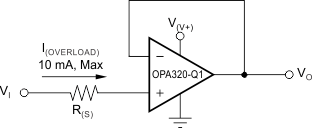ZHCSCS6B September 2014 – December 2018 OPA2320-Q1 , OPA320-Q1
PRODUCTION DATA.
7.3.1 Input and ESD Protection
The OPAx320-Q1 incorporate internal electrostatic discharge (ESD) protection circuits on all pins. In the case of input and output pins, this protection primarily consists of current-steering diodes connected between the input and power-supply pins. These ESD protection diodes also provide in-circuit input overdrive protection, provided that the current is limited to 10 mA, as stated in the Absolute Maximum Ratings. Many input signals are inherently current-limited to less than 10 mA; therefore, a limiting resistor is not required. Figure 29 shows how a series input resistor (R(S)) may be added to the driven input to limit the input current. The added resistor contributes thermal noise at the amplifier input and the value should be kept to the minimum in noise-sensitive applications.
 Figure 29. Input Current Protection
Figure 29. Input Current Protection